An examination of this design philosophy in relation to One Central Park, Sydney, Australia.
Biophilia, bio urbanism, biomimicry or biomorphic design… The number of variations to the term bio seem endless today so you might well wonder if this isn’t just another elaborate buzzword which greenwashing marketers have come up with?
The term “biophilia” means “love of life or living systems.” Unlike phobias, which are the aversions and fears that people have of things in their environment, philias are the attractions and positive feelings that people have toward organisms, species, habitats, processes and objects in their natural surroundings.
Biophilia was first used by Erich Fromm the celebrated social psychologist and philosopher to describe a psychological orientation of being attracted to all that is alive and vital. The biophilia hypothesis suggests that humans possess an innate tendency to seek connections with nature and other forms of life. The concept was popularised by Edward O. Wilson, the acclaimed American biologist through this book, Biophilia (1984). In his view the deep affiliations humans have with other life forms and nature are rooted in our biology. He also observed how increasing rates of urbanisation were leading to a disconnection with the natural world. In coming decades, it is projected that 70 percent of the world’s population will live in cities so biophilia is a becoming an increasingly relevant issue in terms of public health and well-being.
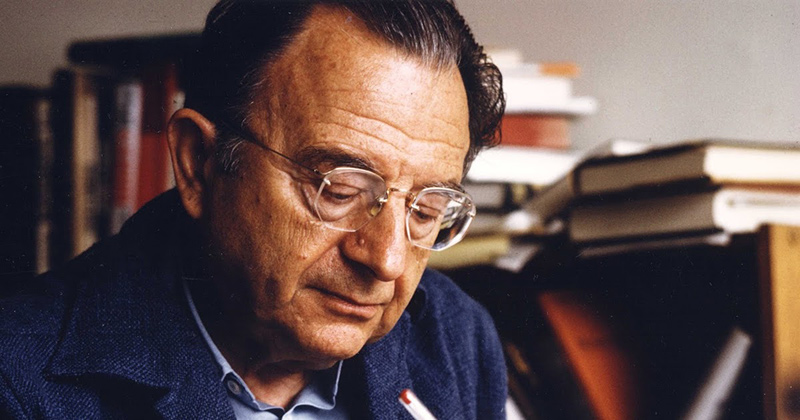
Erich Fromm, the first user of the term Biophilia. Born: 23 March 1900, Frankfurt, Germany. Died: 18
March 1980, Muralto, Switzerland.
Neuroscience shows that Biophilia works
The last decade has seen a steady growth in research work around the intersections of neuroscience and architecture. Recent research demonstrates the measurable, positive impacts of biophilic design on health and reduction of stress raising its priority level within both design research and design practice. Green building standards have begun to incorporate biophilia increasingly. Studies in the US have uncovered measurable benefits in a variety of fields and types of buildings.
For instance, hospitals incorporating biophilic design principles have demonstrated improved rates of post-operative recovery — with less pain, 8.5% shorter stays and 22% less medication for their patients. There are benefits for everyone including staff who can enjoy greater focus on their work. Schools have demonstrated that children learn 20-25% faster when natural light is present. With the emergence of the green building movement in the early 1990s, linkages were also made between improved environmental quality and worker productivity.
According to a report by Human Spaces, 63% of office workers in Europe, the Middle East and Africa (EMEA) are now working in urban areas. In European offices, 42% of employees have no natural light, 55% don’t have access to greenery and 7% have no windows. The Human spaces report shows that office buildings that integrates biophilic design elements generate an impressive 13% increase in the level of wellbeing and demonstrate an 8% rise in productivity. These elements include access to natural light, views on to nature, natural textures, materials and colours plus recuperation spaces to restore mental and physical energy.
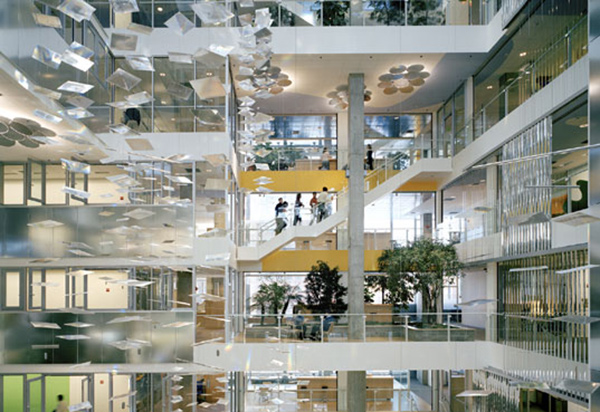
The Genzyme Center, Massachusetts, US, designed by Behnisch Architecture, incorporates the principles
of Biophilia into its design
Big businesses adopt Biophilic principles
Businesses at the vanguard of work place design such as Apple, Google and Amazon are investing heavily in Biophilic Design elements. These principles are shown to improve worker concentration, engagement and cognitive ability but also to attract and retain staff in the “war for talent” (taken from the Human Spaces report “The Impact of Biophilia” Most of these biophilic design principles could be considered simply as a rediscovery of intuitively obvious ideas that have been circulating amongst designers for centuries from Egyptian times to Frank Lloyd Wright. But the scientific evidence is there now to demonstrate the positive benefits of the human-nature connection on our health and wellbeing. One Central Park the design project described below illustrates how some of these biophilic
design principles can be applied even to high rise buildings.
One Central Park Sydney or OCP
When we talk about sustainable design or ‘green buildings’ we usually mean that they are designed to minimize their impact on the environment or carbon footprint. But, increasingly architects are integrating vegetation into their buildings to the greater benefit of its residents. One Central Park in Sydney, for example, features two iconic, richly planted residential towers rising above a retail centre, intimately connected by terraced gardens to the main park beyond. A hanging garden transforms the look of the buildings from a pristine tower of glass and steel into something a lot more natural and organic looking.
Central Park defines Sydney’s ‘Downtown’ and is situated within Sydney’s education precinct, adjoining several high rise University buildings. Pritzker prize winner Jean Nouvel designed One Central Park (OCP) with local collaborator PTW Architects. OCP set out to be the first landmark building of the Central Park precinct and was completed in January 2014.
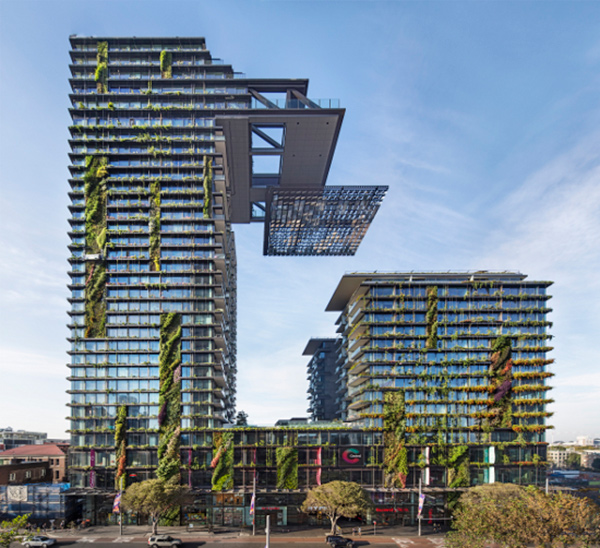
One Central Park, Sydney, Australia, designed on Biophilic principles
OCP’s eastern residential tower rises to 116m (matching the height of one of the existing University buildings) and the western tower to 64.5m high. These towers are mixed-use residential and retail containing 623 residential apartments, above a five level, 16,000sqm retail and recreation podium. OCP’s distinctive and defining profile is provided by a massive steel cantilever extending 80 metres from Level 29 of the East tower. The unexpected nature of this structure is bold and may appear whimsical, yet it is a direct response to the challenges presented by the mass and placement of the taller tower on the northern corner of the Central Park precinct. The relative heights of the two towers – East at 116m high and West at 64.5m high – is driven by the desire to integrate sun-tracking mirrored panels on the roof of the lower tower to re-direct light into the retail atrium, landscape and other parts of the site which would otherwise be in shadow. An assembly of motorised mirrors capture by sunlight and reflect it down onto the building’s gardens. Research had confirmed the essential role played by sunlight light on our health and wellbeing because it governs on our circadian rhythms.
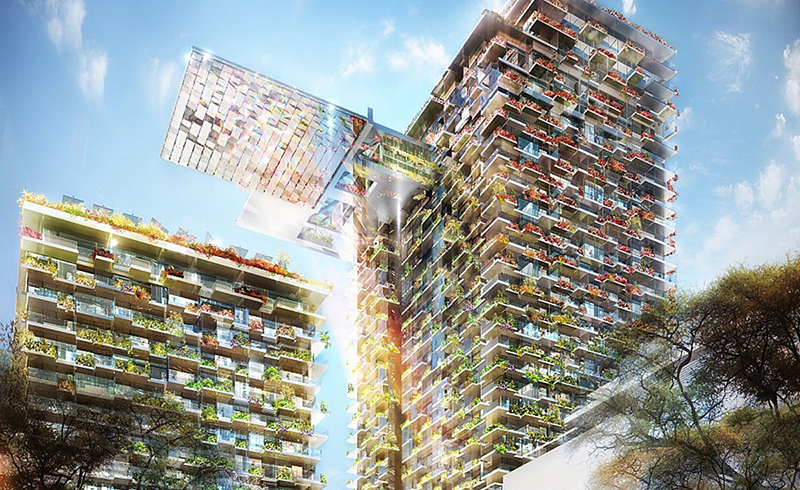
Concept for One Central Park, Sydney by Jean Nouvel and PTW Architects
Innovative use of structural steel
The engineering challenge presented by the cantilever and heliostat required an integrated multidisciplinary collaboration spanning three years involving a large team of engineers, architects and specialists led by Robert Bird Group. The innovative use of structural steel realised the architectural intent of a cantilevered Sky Garden extending 25m beyond the East tower façade as well as supporting the reflector mirror array that extends an additional 20m from the Sky Garden, 94m above ground floor level. Deep steel truss sections form the base structure of the cantilever.
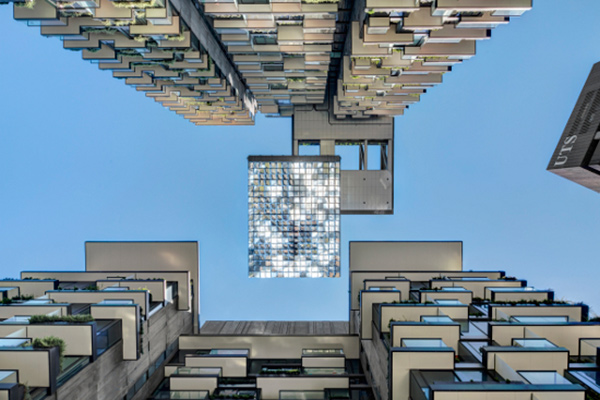
Looking up at the structure with its cantilevered “garden”, One Central Park, Sydney by Jean Nouvel and PTW Architects
Bridge-building techniques were employed to build the cantilever safely at heights avoiding the use of formwork or excessive scaffolding. The 200-tonne cantilever structure was built in three lift-able boxes that could be safely pre-fabricated on the ground. The design successfully managed to level-out the expected elastic deformations of the structure as it settled into place following installation.
A chandelier for the city
Cantilevering a further 20m from the Sky Garden, the heliostat reflector frame carries 500 sqm of reflective mirrored panels. These fixed mirrors are arranged in clusters targeting pre-determined areas at ground and podium levels across Central Park. Forty sun- tracking motorised heliostats measuring 4sqm located on the roof of the West tower are designed to follow the sun’s path throughout the day and reflect the light up onto the fixed mirrors on the underside of the reflector frame. At night, each mirrored panel on the cantilever is fitted with coloured LED’s (2880 in total) that play Yann Kersale’s ‘Sea Mirror’ lighting artwork. 16,000 colours are used in the artwork, produced by a complex system of trichromic LED dots especially designed for this project. The result is a “chandelier for the city” according to Atelier’s Jean Nouvel’s design.
The world’s largest hydroponic vertical gardens
Designed by artist and botanist Patrick Blanc, the vertical gardens of One Central Park span 1200sqm. So, the heliostat also helps to sustain the 370 different plant species that stretch from the park onto the facades of both towers – expressed as vertical gardens on the East and North facades and wrapping both towers in 7 linear kms of metal clad planter boxes, connected floor to floor with stainless steel latticed tensioned vine climbing cables to encourage a soft, green ‘veil’ to develop over time. Again, this meets another important biophilic design criteria: whether it is through their windows or walking through one of the many planted terraces, residents of OCP will benefit from this physical contact with nature, which can improve focus and create a greater sense of calm.
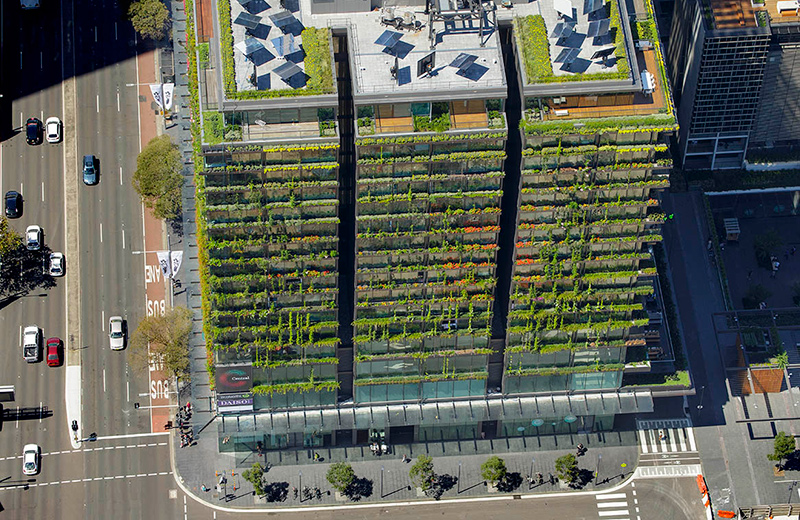
One Central Park’s hydroponic gardens, spanning 1200 square metres, by Patrick Blanc
Spanning ground level to 116 metres high, with a mix of sunny and shady microclimates, all affected by occasional high winds, these vertical gardens were a great horticultural challenge. The plant selection expanded to include 370 native and exotic species, and – ultimately – 35,000 individual plants. Maintenance methods and scheduling included installing a precinct-scale water recycling facility within the basement of a residential building which was also unprecedented.
The Green Roof
Other landscape features at One Central Park include a green roof of One Central Park West (not accessible by residents) surrounding the heliostat reflective structures and offering an appealing outlook for residents on upper levels of One Central Park East. The penthouses on top levels include planted terraces but there are also further landscape elements on the pool area on level 5 and a massive internal sloping green wall within the Central retail centre to encourage shoppers to reach out and touch the gardens.
Inside the towers biomorphic interior designs revolving around the appearance of nature be it in form of a garden, a material or an image dominate. For example, the East Lobby has bamboo gardens and curved bamboo panels on its walls, the Atrium has an underground garden lit by heliostats, and the West Lobby has a monumental image of a Eucalyptus forest. The ethereal and curvaceous East Lobby evokes the sky, the lush stands of bamboo bring the natural world inside – a natural extension of AJN’s overarching organic ethos for One Central park.
Appendix: What makes good biophilic design?
In their defining study 14 Patterns of Biophilic design, Terrapin Bright Green LLC describe good biophilic design as ‘the designing for people as a biological organism, respecting the mind-body systems as indicators of health and well-being in the context of what is locally appropriate and responsive. Above all, biophilic design must nurture a love of place’.
In their hallmark study Terrapin organize Biophilic design in three main categories. Firstly, Nature in the Space which could be summarized as experiencing the presence of nature through the different senses, whether it be by a visual connection, presence of water, light and shadow variations, seasonal variations or more subtle changes in air temperature, humidity or airflow and surface temperatures that mimic natural environments.
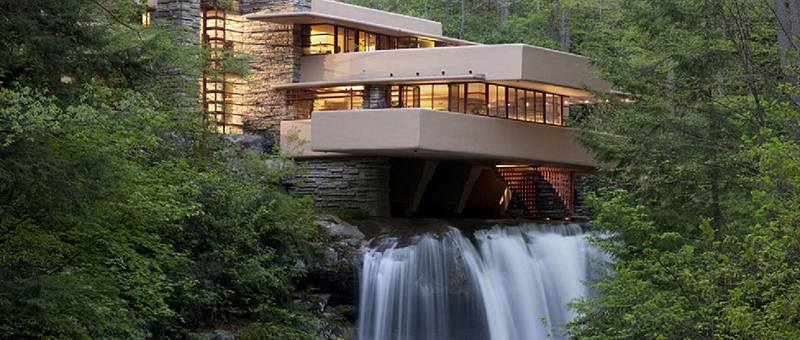
Falling Water by Frank Lloyd Wright embodies the principles of Nature in Space as defined by Terrapin Bright Green in their study 14 patterns of Biophilic design.
Secondly, Natural Analogues refer to all design solutions that use non-living or indirect evocations of nature: here we recognize typically the design worlds of William Morris or the Art Nouveau movement. Mimicry of shells and leaves, furniture with organic shapes, and natural materials that have been processed or extensively altered, each provide an indirect connection with nature: while they are real, they are only analogous of the items in their ‘natural’ state. Natural Analogues include different patterns of biophilic design such as Biomorphic Forms & Patterns (symbolic references to contoured, patterned, textured or numerical arrangements that persist in nature) or Material Connection with Nature (materials and elements from nature that, through minimal processing, reflect the local ecology or geology) and create a distinct sense of place.
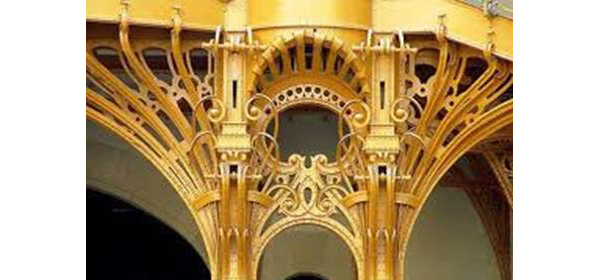
Art Nouveau supporting arch by Victor Horta, Belgium
Thirdly, Nature of the Space addresses spatial configurations in nature and include biophilic design patterns such as prospect (or views) refuge (a place for withdrawal from the main flow of activity, in which the individual is protected from behind and overhead) but also subjective sensations such as mystery and risk or peril. The strongest Nature of the Space experiences are achieved through the creation of deliberate and engaging spatial configurations commingled with patterns of Nature in the Space and Natural Analogues.
Most of these biophilic design principles could be considered simply as a rediscovery of intuitively obvious ideas that have been circulating amongst designers for centuries from Egyptian times to Frank Lloyd Wright. But the scientific evidence is now there to demonstrate the positive benefits of biophilic design on our health and well-being. The design project, One Central Park in Sydney illustrates how biophilic principles can be applied even to high-rise.